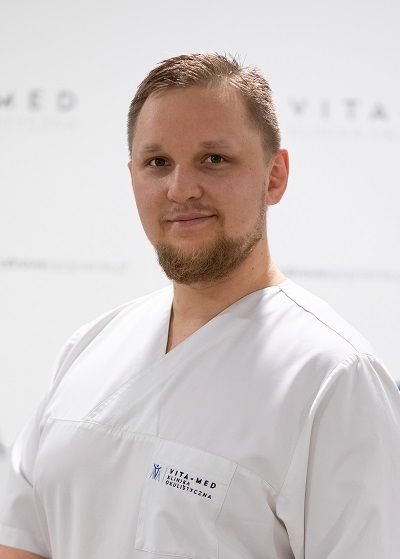Laser therapy
We have a modernly equipped laser laboratory for the treatment of retina and macula. We have the most modern equipment, based on fiber optic technology, yellow, green, Nd: YAG lasers and micropulses with a wavelength of 577 nm.
Expert recommendation
Laser therapy is recognized as one of the most effective therapeutic methods in the treatment of eye diseases. It is performed on an outpatient basis. The use of laser technology minimizes the risk of serious complications leading to intravitreal hemorrhages and retinal detachment as a result of vitreo-retinal traction.
A special lens is put on the eye through which the doctor performs laser therapy. The length of the procedure depends on the type of disease and may last from several to several dozen minutes. During the procedure, the patient sees flashes of light, similar to shining a flashlight in front of the eye . The patient feels no pain.
Dr. Karol Nienartowicz
Ophthalmologist
Retinal
laser therapy is also known as laser photocoagulation. This procedure is performed in the treatment of various diseases of the retina, such as:
- diabetic retinopathy,
- retinal vascular embolism,
- damage to the peripheral retina (tears, holes or degeneration of the retina, threatening its detachment),
- peripheral degenerative changes of the retina,
- delamination,
- central retinal vein clot,
- changes in the spots
- retinal macrotaneurysms,
- other diseases of the retina and choroid.
Our laser workshop is equipped with:
- micropulse laser,
- 532 nm photocoagulation laser,
- 577 nm photocoagulation laser,
- YAG neodymium laser.
Information for the patient before the laser treatment:
In our center, laser treatments are performed on three types of lasers: green double harmonic diode photocoagulation laser and YAG neodymium photo-disruptive laser.
You should reserve about 4-5 hours for the entire procedure of the laser treatment.
Dear patient! If you have a planned surgery due to retinal disease, check if you have forgotten to take your fluorescein angiography pictures with you! (This does not apply to patients with retinal openings.)
On the designated day and time of the procedure, please report to the registration office, from where you will be directed to the appropriate surgery. In the doctor’s office, the nurse taking care of you will perform preparations for the procedure. He will complete the medical records and give the appropriate medications. The preparation time for the procedure usually takes from 30 minutes to 2-3 hours and depends on the individual characteristics of a given eye.
After preparation, the nurse will take you to the hospital part of the Laser Laboratory. You will receive additional eye drops to numb your eye. A special lens will be placed over the eye. The laser treatment requires extreme precision, down to micrometers. During the entire procedure, you should sit still and look at the point indicated by the doctor. You must not move your head and eye! The forehead must be pressed against the camera and the chin must rest firmly. You will see flashes of light in front of the eye. Occasionally, some laser impacts can be painful. You should inform your doctor about this, but you must not change the position of the head and eye. Movement can cause irreversible damage to the eye structures! The time of the procedure is usually 5-20 minutes.
Immediately after the laser treatment, vision is blurred due to the temporary glare of the eye with laser light, the presence of residual protective viscoelastic substance in the conjunctival sac and deformation of the cornea by the contact lens used. There is also discomfort associated with the applied corneal anesthesia. A few minutes after the procedure, vision clearly improves, but may not return to the level before photocoagulation, especially when the laser treatment was performed in the macula or the photocoagulation was intense. A temporary decrease in visual acuity as a result of macular edema may last from a few hours to about 2 weeks. Therefore, usually only one eye is photocoagulated when visual acuity is expected to decline. If the patient has surgery on the only sighted eye, he should come to an accompanying person,
After the laser treatment, you will be taken back to the outpatient unit, your eye will be washed and your eye will be instilled with medication. Sit with your eyes closed in the waiting room. Half an hour after the procedure, the intraocular pressure will be checked. If you experience pain or discomfort in the eye after the procedure, inform the nurse about this fact. The nurse will inform you what to do next. You will be given a prescription for the drugs together with information on how to use them. Glaucoma patients must continue to use glaucoma medications as usual!
The next day, patients are monitored for the anterior segment of the eyeball and for intraocular pressure. You will be informed about the time of the follow-up visit.
You should not come to the laser treatment as a driver, because blurred vision and photophobia after the treatment will make driving difficult. It’s a good idea to bring sunglasses to protect your eyes from excessive light, which is especially important on sunny days.
Laser treatment in diabetes is aimed at stabilizing vision and protecting the eye against visual acuity deterioration.
Possible side effects and complications
Most of the side effects are related to the eye drops that dilate the pupil and not the laser itself. After laser therapy, the following may occur:
- increase in intraocular pressure (including acute glaucoma attack),
- eyeball irritation and eye inflammation,
- bleeding inside the eye,
- blurred vision – loss of contrast.

